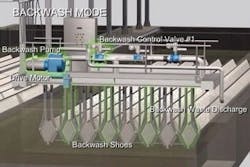Cloth Media Filter Retrofit Solves Plant's Hydraulic Loading Problem
Little Falls Run Wastewater Treatment Facility (WWTF), one of two treatment facilities owned by Stafford County, Va., began operation in 1991. It was constructed to accommodate the area’s growing population. The plant’s original treatment scheme included an activated sludge system with a secondary clarifier and dual-bay traveling bridge sand filters, each 16 ft wide and 44 ft long, for tertiary filtration.
ProblemIn 2003, the plant began experiencing problems with the sand filters initiating continuous backwash mode when flows exceeded 6 million gal per day (mgd), or 3 gpm/ft?, significantly less than the rated capacity. To remedy the problem, plant operators were bypassing a portion of the flow. With flows expected to increase and anticipated tougher discharge limits, Stafford County began investigating a solution.
Initial consideration included doubling the filter capacity by duplicating the existing traveling bridge filter process. This involved constructing identical cast in-place concrete tanks with matching filter underdrains, dual-media and traveling bridges. Significant drawbacks to this included very limited land space without future expansion possibilities, concerns about the actual capacity of the expanded filters and expected downtime during construction.
Stafford County decided to investigate an alternative solution of two AquaDiamond cloth media filters that could double their hydraulic capacity within the existing sand filter footprint. This retrofit would require only minor structural modifications for approximately the same cost as duplicating the original filter process. This benefit, combined with the successful operation of an AquaDisk cloth media filter at their sister facility, prompted Stafford County to conduct a three-week pilot program at Little Falls Run WWTF. The pilot demonstrated the AquaDiamond filter’s ability to meet stricter design limits under extreme hydraulic and solids loading conditions.
SolutionAs a result of the pilot's success, the expansion was then designed with AquaDiamond cloth media filters. The existing traveling bridge sand filter basins were to be retrofitted with the cloth media filters one at a time to reduce interference with plant operations. The first AquaDiamond filter went into operation in August 2005, within six weeks of the sand filter being taken out of service. A testing period followed to validate performance requirements prior to removing the second sand filter from operation. Again, performance results were excellent,,so the second sand filter was retrofitted in September 2005.
Little Falls Run WWTF currently has a design average daily flow of 6.0 mgd and actual flow of 3.45 mgd. Current discharge limits for the plant include 9 mg/L BOD, 9 mg/L total suspended solids and 2 mg/L total phosphorus. The plant expects more stringent discharge limits in the near future of 4.5 mg/L BOD, 4.5 mg/L total suspended solids and 0.5 mg/L total phosphorus.
The AquaDiamond filters consistently produce effluent total suspended solids below the expected future limits of 4.5 mg/L. In fact, stringent testing has shown excellent results of an average effluent total suspended solids of 2.4 mg/L with only one filter online.
The low backwash waste volume generated has been especially impressive. The results were 0.1% of total throughput in initial startup testing and 0.3% during the most recent one-month testing period, compared to typical rates of 1% to 3%.
“By selecting this technology, the facility has preserved valuable space for a later expansion, while preparing for more stringent discharge limits in the near future,” said Keith Dayton, assistant director of utilities.
For more information, please contact Robert Batek, P.E., at 815.639.4465 or [email protected] .
